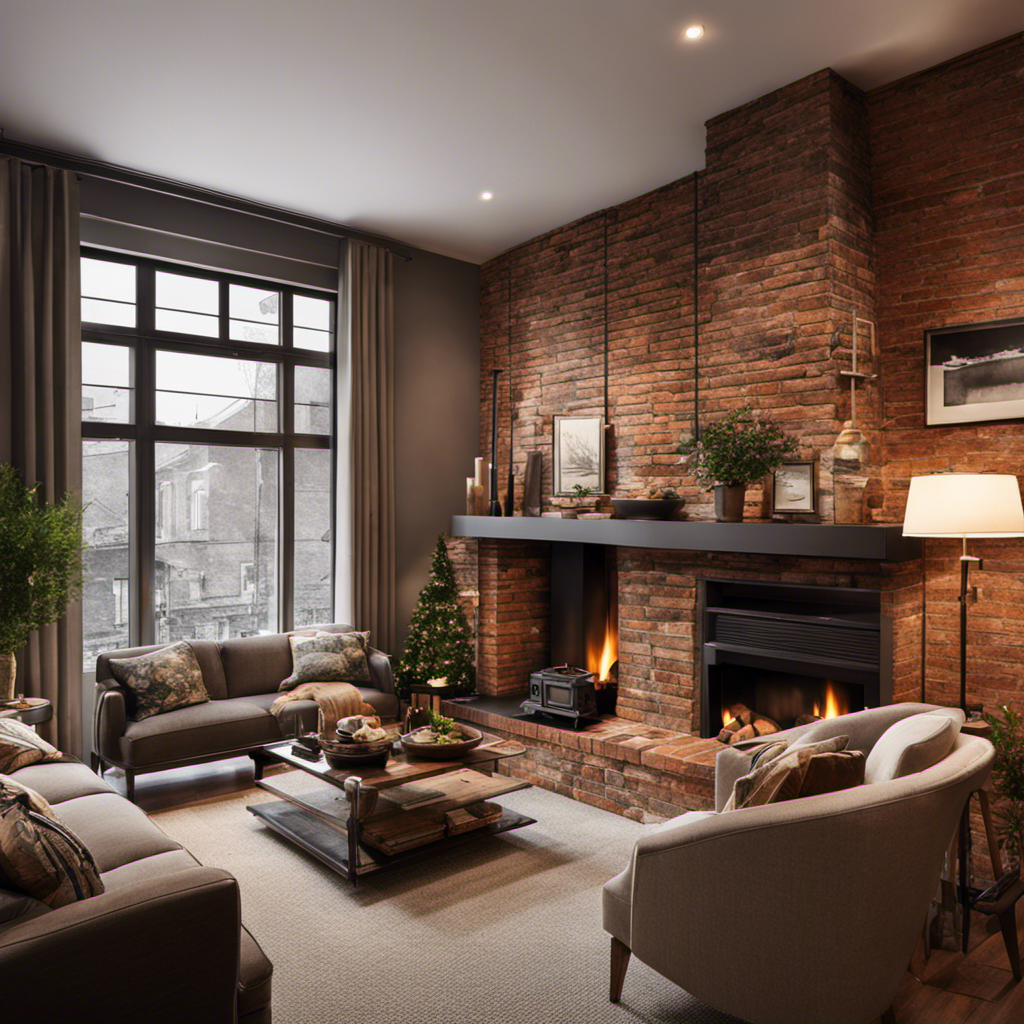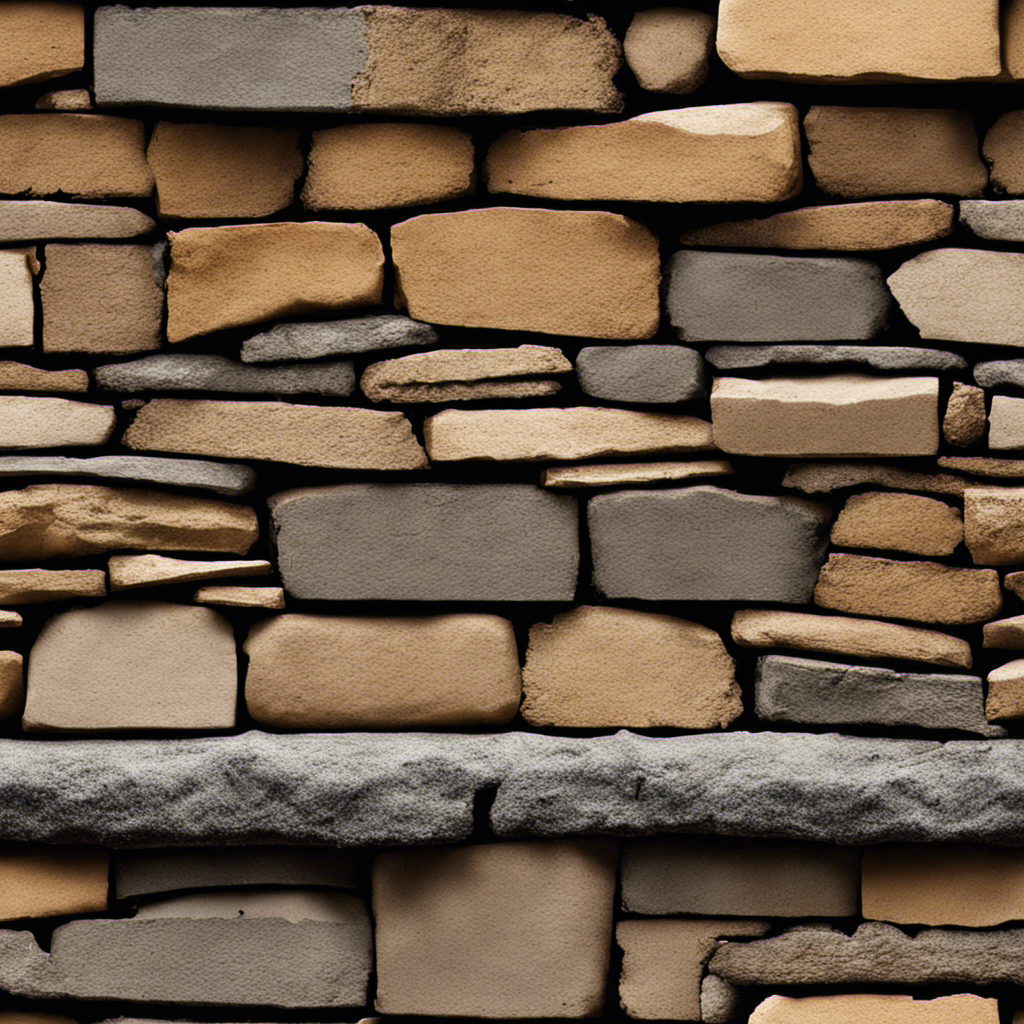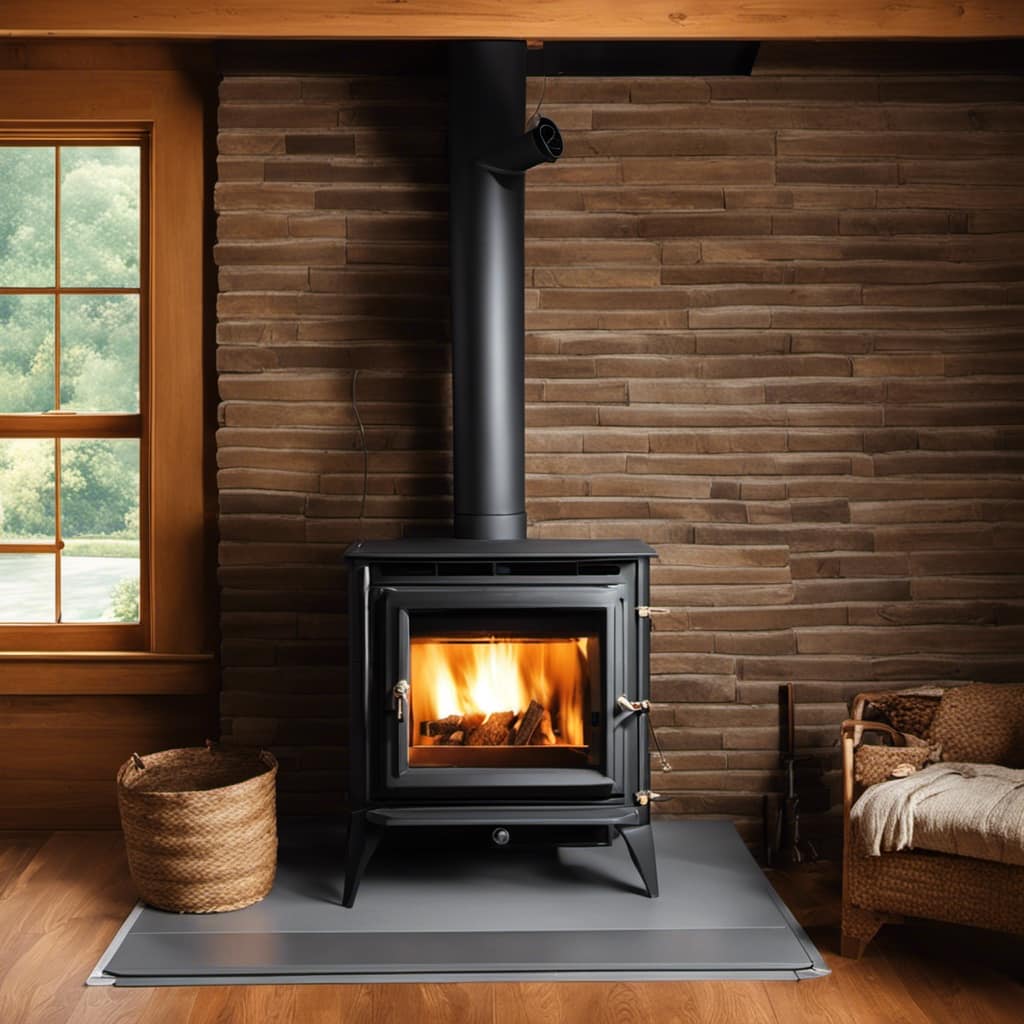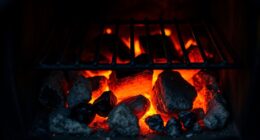Are you looking to elevate your home’s atmosphere with the cozy warmth of a wood stove? While it may seem straightforward to install one, it’s crucial to think about several factors such as compliance with building codes, safety precautions, and ventilation choices.
And don’t forget about space, fuel sources, heating efficiency, installation costs, and maintenance requirements. It’s a lot to think about, but fear not! In this article, I’ll guide you through the ins and outs of installing a wood stove in your apartment.
Let’s get started!
Key Takeaways
- Research building regulations and safety concerns for wood stove installation in your area to ensure compliance and safety.
- Obtain landlord approval and assess ventilation options before installing a wood stove in your apartment.
- Consider space and layout, explore fuel sources, and calculate heating efficiency when choosing a wood stove.
- Regular maintenance and cleaning of the wood stove, proper ventilation, and fire hazard precautions are essential for safety.
Understanding Building Regulations
I need to research if there are any building regulations that would prevent me from installing a wood stove in my apartment. Understanding legal restrictions is crucial when it comes to making any modifications to your living space. Building regulations vary from place to place, so it’s essential to consult with the local authorities to ensure compliance. In this case, contacting the fire department would be a good starting point.
Building regulations primarily focus on safety measures and fire prevention. They aim to protect residents and their property from potential hazards. The fire department will have detailed information about the specific regulations in your area. They can provide guidance on whether installing a wood stove is allowed and if there are any additional requirements or permits needed.
It’s important to note that building regulations are in place for a reason. They’re designed to ensure the safety and well-being of everyone in the building. By consulting with the fire department, you can gain a better understanding of the legal restrictions and take appropriate steps to comply with them.
Transitioning into the next section about evaluating safety concerns, it’s crucial to consider the potential risks associated with installing a wood stove and how to address them effectively.
Evaluating Safety Concerns
When evaluating safety concerns for installing a wood stove in my apartment, it’s important to consider several factors.
Firstly, I need to assess the fire hazard precautions, such as the proximity to flammable materials and the availability of fire extinguishers.
Additionally, proper ventilation requirements must be met to ensure the safe release of combustion gases.
Lastly, obtaining landlord approval is crucial to ensure compliance with building regulations and to address any potential concerns.
Fire Hazard Precautions
Installing a wood stove in my apartment requires taking fire hazard precautions. Fire prevention is of utmost importance when dealing with wood stoves.
One essential precaution is to have a fire extinguisher readily available. This will help in case of any unforeseen fire emergencies. It’s crucial to choose a fire extinguisher that’s suitable for combating wood fires, such as a Class A extinguisher. Additionally, it’s recommended to have multiple fire extinguishers strategically placed throughout the apartment, ensuring easy access in case of a fire outbreak.
Regular maintenance and cleaning of the wood stove also play a vital role in fire prevention. Properly disposing of ashes and ensuring the stovepipe and chimney are clear of debris significantly reduce the risk of fire hazards.
Ventilation Requirements
Proper ventilation is essential for the safe operation of a wood stove. When installing a wood stove in your apartment, it’s crucial to evaluate the air circulation to ensure that there’s enough fresh air coming into the room and proper exhaust for the smoke to exit.
Inadequate ventilation can lead to a buildup of carbon monoxide, a colorless and odorless gas that can be extremely dangerous. Understanding the carbon monoxide risks associated with wood stoves is vital for your safety and the safety of those around you. It’s important to have a working carbon monoxide detector in the area where the wood stove is installed to monitor any potential leaks.
With proper ventilation and awareness of carbon monoxide risks, you can enjoy the warmth and comfort of a wood stove in your apartment. However, it’s essential to seek landlord approval before installing a wood stove to ensure compliance with building codes and safety regulations.
Landlord Approval Needed
I need to obtain landlord approval to ensure compliance with building codes and safety regulations before proceeding. It’s important to communicate with the landlord about any significant changes to the apartment, such as installing a wood stove. This won’t only help maintain a good relationship with the landlord but also ensure that the necessary permits and inspections are obtained.
Additionally, it’s crucial to review the terms of the lease agreement to determine if there are any restrictions or limitations on modifications to the property. It’s also recommended to check if the insurance coverage on the apartment includes wood stoves, as this could impact liability in case of any accidents or damages.
Once the landlord’s approval is obtained, it’s time to assess the ventilation options for the wood stove installation.
Assessing Ventilation Options
My landlord mentioned that a window fan might help with the ventilation. So, I decided to evaluate the cost and research local resources for finding the best window fan for my apartment. I started by comparing prices online and reading reviews from other customers to make an informed decision. After narrowing down my options, I visited a few local stores to see the fans in person and get a better sense of their quality. I also spoke to the salespeople who were knowledgeable about the different features and benefits of each fan.
During my research, I discovered that some local hardware stores offer installation services for window fans. This was great news because it meant that I wouldn’t have to worry about installing it myself. I contacted a few of these stores to get quotes and inquire about their availability. It’s important to consider both the cost of the fan itself and the installation service when evaluating the overall expense.
Considering the importance of proper ventilation in my apartment, I wanted to make sure I made the right choice. After careful evaluation and research, I finally settled on a window fan that met my requirements and budget. With the ventilation issue addressed, I can now move on to considering the space and layout of my apartment to determine if a wood stove is feasible.
Considering Space and Layout
After assessing the ventilation options, I carefully considered the space and layout of my living area to determine if a wood stove would be feasible. Space utilization is a crucial factor when it comes to installing a wood stove in an apartment. My living area is relatively small, so I’d to make sure that there was enough space to accommodate the stove while still allowing for comfortable movement around the room. Additionally, I’d to consider the placement of furniture and other items to ensure they wouldn’t be too close to the stove and pose a fire hazard.
Aesthetic considerations were also important to me. I wanted the wood stove to blend seamlessly with the overall design of my apartment. Fortunately, there are a variety of styles and finishes available, allowing me to choose one that matches my existing decor. I also considered the visual impact of the stove in the room. I wanted it to be a focal point, adding warmth and charm to the space.
Overall, after carefully assessing the space utilization and aesthetic considerations, I determined that installing a wood stove in my apartment is indeed feasible. It won’t only provide efficient heating but also enhance the overall ambiance of my living area.
Exploring Fuel Sources
When considering fuel sources for heating, I researched the benefits and drawbacks of different options. One of the main factors I looked into was fuel efficiency, as I wanted to find a heating source that wouldn’t only keep me warm but also save me money in the long run.
I found that wood stoves are known for their high fuel efficiency. They can achieve an efficiency rating of up to 80%, which means that 80% of the heat generated from burning wood is effectively used to heat the space. This is significantly higher than other fuel sources such as natural gas or oil.
However, it’s important to consider the environmental impact of using wood as a fuel source. While burning wood is considered carbon neutral, as the emissions released are roughly equal to the carbon absorbed by the tree during its growth, it can still contribute to air pollution. Wood burning releases particulate matter and other pollutants, which can be harmful to air quality, especially in densely populated areas.
In conclusion, wood stoves offer high fuel efficiency, making them a cost-effective heating option. However, it’s important to weigh this against the potential environmental impact.
Transitioning into the next section, I’ll now delve into the process of calculating heating efficiency.
Calculating Heating Efficiency
When it comes to calculating heating efficiency, there are a few key factors to consider.
First, you’ll want to evaluate the energy-saving heating methods available, such as using a programmable thermostat or insulating your home properly.
Next, it’s important to assess stove performance, looking at factors like BTU output and combustion efficiency.
Lastly, maximizing heat distribution throughout your space can significantly impact overall efficiency.
Energy-Saving Heating Methods
I can save energy by using alternative heating methods like a wood stove. In addition to reducing my carbon footprint, there are other ways to make my heating system more energy efficient.
First, I can invest in energy-efficient appliances. These appliances are designed to use less energy without compromising their performance. For example, I could replace my old furnace with a newer, more energy-efficient model.
Second, proper insulation techniques can also help conserve energy. By properly insulating my home, I can prevent heat loss and keep the warm air inside. This can be done by insulating walls, windows, and doors.
Together, using alternative heating methods, energy-efficient appliances, and insulation techniques can significantly reduce my energy consumption and save me money on heating bills.
Evaluating Stove Performance
Evaluating the performance of my alternative heating method is crucial in determining its energy efficiency and effectiveness. When it comes to evaluating stove efficiency and comparing stove models, there are a few key factors to consider:
-
Heat output: How much heat does the stove produce? Look for stoves with high BTU ratings.
-
Fuel consumption: How much fuel does the stove consume? Opt for stoves that are efficient and burn fuel cleanly.
-
Heating capacity: Can the stove adequately heat the desired space? Consider the square footage and insulation of your home.
By evaluating these factors, I can determine which stove model will best meet my heating needs.
Maximizing heat distribution is the next step in ensuring an efficient heating system.
Maximizing Heat Distribution
To ensure efficient heating, I focus on maximizing heat distribution in my home. When evaluating energy efficiency, one important factor to consider is the size of the heating system. Choosing the right size ensures that the heat output matches the needs of the space, preventing wastage or insufficient heating.
In my experience, I’ve found that a properly sized heating system not only saves energy but also improves comfort levels. To maximize heat distribution, I strategically place furniture and curtains away from heat sources such as radiators or vents. I also use fans or ceiling fans to circulate warm air throughout the room.
Additionally, I make sure that doors and windows are properly sealed to prevent heat loss. By implementing these strategies, I’m able to achieve optimal heat distribution in my home, resulting in efficient and effective heating.
Budgeting for Installation Costs
Installing a wood stove in my apartment includes budgeting for the installation costs. There are several factors to consider when evaluating installation options and comparing installation quotes. Here are some important points to keep in mind:
-
Safety regulations: Ensure that the installation complies with local building codes and regulations. This may involve hiring a professional installer who’s knowledgeable about these requirements.
-
Chimney requirements: A wood stove requires a functioning chimney for proper ventilation. Assess the condition of your existing chimney and determine if any repairs or modifications are necessary.
-
Installation materials: Consider the cost of materials needed for the installation, such as stove pipes, chimney liners, and heat shields. These materials should be of high quality to ensure the safe operation of the wood stove.
When comparing installation quotes, it’s essential to obtain multiple estimates from reputable installers. Evaluate the breakdown of costs, including labor, materials, and any additional services offered. Don’t solely focus on the price; also consider the installer’s experience, reputation, and customer reviews.
Researching Maintenance Requirements
Now that I’ve budgeted for the installation costs of my wood stove, it’s important to research the maintenance requirements to ensure it operates efficiently and safely. Regular maintenance is crucial to extend the lifespan of the stove and prevent potential problems.
One of the maintenance tips for wood stoves is to clean the chimney regularly. Creosote buildup can occur over time and increase the risk of a chimney fire. Hiring a professional chimney sweep is recommended, as they have the expertise and equipment to thoroughly clean the chimney.
Another common problem with wood stoves is the accumulation of ash and debris. It’s important to clean out the firebox regularly to prevent any blockages and ensure proper airflow. Additionally, inspecting the stove’s gaskets and door seals for wear and tear is essential. Damaged seals can lead to air leaks and reduce the stove’s efficiency.
Regularly checking the chimney cap and spark arrestor is also necessary. These components can become clogged with debris, hindering proper ventilation. It’s important to remove any obstructions and ensure they’re in good condition.
Seeking Professional Advice
I sought professional advice to ensure the proper maintenance of my wood stove. As an apartment dweller, it’s crucial for me to follow the necessary guidelines and recommendations to keep my wood stove functioning efficiently and safely.
Here are some key points I learned from the professionals:
-
Regular Cleaning: It’s essential to clean the stove regularly to prevent the buildup of soot and creosote, which can pose a fire hazard. A professional recommended using a wire brush and a vacuum designed for ash removal.
-
Chimney Inspection: A qualified installer should inspect the chimney at least once a year to ensure it’s free from blockages and in good working condition. They also suggested installing a chimney cap to prevent animals from entering.
-
Proper Use of Fuel: Using the right type of wood and ensuring it’s properly seasoned is crucial for efficient and safe operation. Professionals recommended using hardwoods like oak, maple, or hickory and avoiding softwoods like pine.
Finding qualified installers and professionals who specialize in wood stove maintenance is key. They have the knowledge and experience to provide the necessary recommendations and ensure that your wood stove is operating at its best.
Remember to consult with professionals to ensure the safety and longevity of your wood stove.
Frequently Asked Questions
Can I Install a Wood Stove in an Apartment With Carpeted Floors?
Installing a wood stove in an apartment with carpeted floors can be risky in terms of wood stove safety. The heat emitted by the stove can pose a fire hazard to the carpet. Additionally, the weight of the stove may cause damage to the floor.
It’s advisable to consider alternatives to wood stoves, such as electric or gas heaters, which are safer and more suitable for apartments with carpeted floors.
How Often Do Wood Stoves Need to Be Cleaned and Maintained?
Wood stove maintenance is crucial for their safe and efficient operation. The frequency of cleaning depends on usage and the type of wood burned. Typically, it’s recommended to clean and inspect the stove at least once a year by a professional chimney sweep.
This includes removing ashes, cleaning the chimney, and checking for any potential issues. Regular cleaning ensures proper airflow, prevents chimney fires, and extends the lifespan of the wood stove.
Are There Any Restrictions on the Type of Wood That Can Be Used in a Wood Stove?
When it comes to the type of wood you can use in a wood stove, there are some restrictions to keep in mind.
It’s important to choose hardwoods like oak, maple, or cherry, as they burn longer and produce more heat.
Softwoods like pine or cedar can be used, but they burn faster and may create more creosote buildup.
Always follow safety precautions, such as using seasoned wood and keeping your stove well-maintained to prevent any potential hazards.
Can I Use a Wood Stove in an Apartment With Limited Outdoor Space for Storing Firewood?
Living in an apartment with limited outdoor space for storing firewood can be challenging when considering using a wood stove. However, there are alternative heating options available that don’t require the use of firewood.
Electric or gas-powered stoves can provide efficient heating without the need for outdoor storage. Additionally, there are portable wood stoves that can be used indoors and don’t require a large amount of firewood.
Exploring these options can help you find a suitable heating solution for your apartment.
Is It Possible to Install a Wood Stove in an Apartment With a Small Living Room?
Yes, it’s possible to install a wood stove in an apartment with a small living room. However, it’s important to consider wood stove safety and the space requirements.
Wood stoves need proper ventilation and clearances from combustible materials. If your apartment isn’t suitable for a wood stove, there are alternative heating options available such as electric heaters or gas fireplaces.
It’s always recommended to consult with a professional before making any installations to ensure safety and compliance.
Conclusion
In conclusion, installing a wood stove in an apartment requires careful consideration of several factors. These factors include building regulations, safety concerns, ventilation options, space and layout, fuel sources, heating efficiency, installation costs, maintenance requirements, and seeking professional advice.
It’s essential to thoroughly research and understand these factors before proceeding with the installation of a wood stove in an apartment. By doing so, you can ensure that you are making an informed decision and that you are compliant with any building regulations or safety standards that may apply.
So, if you’re looking for a cozy and efficient heating option, it is important to ask yourself: Is installing a wood stove in my apartment the right choice for me? Taking the time to assess all the relevant factors and seek professional advice will help you make an informed decision.
Logan’s affair with adventure began in childhood. He hailed from a small town where vast forests bordered one side and endless shores stretched on the other. His days were spent exploring uncharted woods, climbing tall trees, or listening to the tales of old sailors. This early immersion in a world brimming with stories and mysteries became the foundation of his passion for writing.











